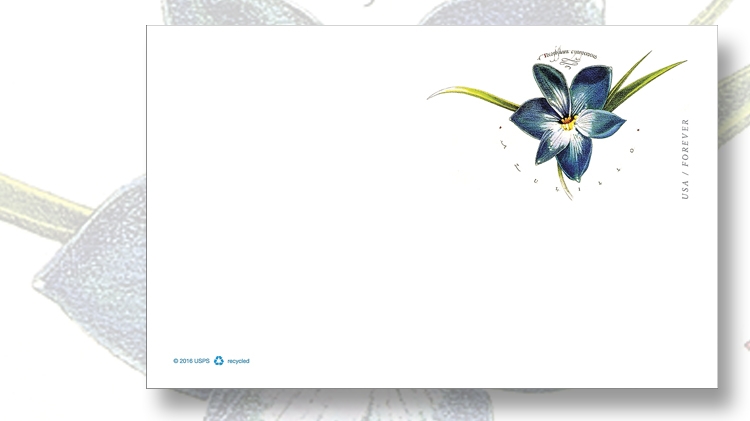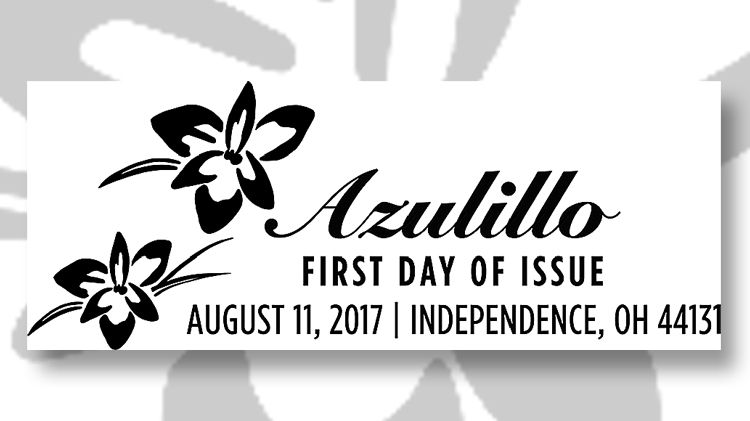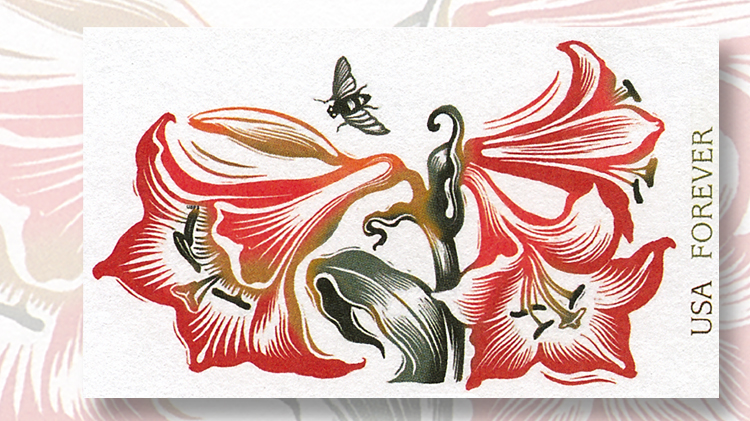US Stamps
Floral illustration by Dugald Stermer on imprinted stamp for U.S. postal card
By Michael Baadke
The month of August is turning into a celebration of all things floral for the United States Postal Service.
On Aug. 11, the USPS will issue three varieties of a new nondenominated (34¢) Azulillo Chilean Blue Crocus forever postal card.
The varieties are the familiar single card; the double-reply card, which offers two postal cards attached by a shared serrated border; and an uncut sheet of 40 cards.
Each postal card bears an imprinted illustrated stamp and fulfills the 34¢ postage rate. The Postal Service charges 38¢ apiece, claiming a 4¢ charge for costs associated with manufacturing.
Connect with Linn’s Stamp News:
Sign up for our newsletter
Like us on Facebook
Follow us on Twitter
The postal card is one of just three U.S. new issues currently planned for August. It was preceded Aug. 3 by the Protect Pollinators set of five stamps, each with a design picturing a different flower being visited by a bee or a butterfly, and it will be followed Aug. 16 by a set of four stamps called Flowers from the Garden, which will be sold in double-sided panes of 20 and large coils.
The postal card will be welcomed with an 11 a.m. first-day ceremony during the opening day of Americover 2017, the annual show and exhibition sponsored by the American First Day Cover Society.
The show is taking place Aug. 11-13 at the Embassy Suites by Hilton Cleveland-Rockside, 5800 Rockside Woods Blvd., Independence, Ohio.
The postal card will be placed on sale nationwide on the day of issue.
The imprinted stamp on the new postal card features an illustration of a Chilean blue crocus (Tecophilaea cyanocrocus). The illustration is described by the USPS as “existing art” created by prominent designer and artist Dugald Stermer (1936-2011).
Stermer’s illustration also includes the flower’s common name, azulillo, in penciled calligraphy below the image, with the scientific name lettered above.
Azulillo loosely translates from Spanish as “little blue thing,” according to the Postal Service.
Stermer’s career as an artist, art director, graphic designer, and illustrator includes his illustration on the cover of the first issue of Mother Jones magazine in 1976, his close association with Ramparts magazine as art director, and his design of the medals awarded during the 1984 Olympic Summer Games in Los Angeles.
His illustrations of nature were included in his books Vanishing Creatures (1981), Vanishing Flora (1995), and Birds & Bees (1995).
USPS art director Ethel Kessler designed the new postal card.
“The Chilean blue crocus is native to a small, mountainous area around Santiago, Chile,” according to the Postal Service. “Though it has survived in cultivation as a landscape and greenhouse plant in the U.S. and other countries, it was believed to be extinct in the wild in its native Chile due to overgrazing, habitat destruction, and an unsustainable export industry. However, a thriving wild population was discovered near Santiago in 2001.
“Despite its name, the Chilean blue crocus is not related to true crocuses from the iris family. It is one of only two species in the genus Tecophilaea. A low-growing plant, its stalk reaches a height between three and five inches, with one to three linear leaves. There are a number of varieties of this species, including the flower featured in the stamp art, var. leichtlinii, with its cobalt blue flowers and white centers. The plant is hardy in U.S. Department of Agriculture zones 7 to 9.”
The prominence of U.S. postal cards, described as “stamped cards” by the Postal Service, has diminished considerably in recent years.
First issued by the U.S. Post Office Department in 1873, the imprinted stamps on postal cards originally bore framed portraits representing an allegorical figure of “Liberty,” before she gave way to President Thomas Jefferson in 1885, Ulysses S. Grant in 1891, John Adams in 1898, and William McKinley in 1902.
In 1956, a bicolor commemorative design for the Fifth International Philatelic Exhibition was used for a 2¢ postal card (Scott UX44), with other commemorative themes appearing just a few years later.
Postal cards featured various patriots of the American Revolution during the bicentennial era, and other historical subjects throughout the 1980s.
A Historic Preservation theme during the same decade showcased stately buildings, often from the campus of a college or university to celebrate a significant anniversary for the school.
As an example, a 19¢ postal card with the imprinted stamp depicting the Main Building on the University of Notre Dame campus (Scott UX157) was issued Oct. 15, 1991, in advance of that university’s sesquicentennial.
Picture postal cards were introduced in 1994 to accompany the Legends of the West stamp set. That first set of 20 19¢ full-color cards (Scott UX178-UX197) included enlargements of the stamp artwork on one side, and a matching imprinted stamp on the message side.
With three such sets issued in 2000, that year saw 49 different U.S. postal cards issued.
The last of the picture postal card issues was the set of 10 32¢ Scenic American Landscapes postal cards issued June 23, 2012 (Scott UX634-UX643).
Only three new U.S. postal cards have been produced in the five years since that Scenic American Landscapes set was issued; the Azulillo postal card will be the fourth. Presumably, it will replace the Fanciful Flowers nondenominated forever postal card (Scott UX646) that was issued July 31, 2015 — more than two years ago.
The sudden reduction of U.S. postal card issues has been dramatic. Even those that are issued and available for purchase have not appeared in recent editions of USA Philatelic, the free USPS retail catalog aimed at stamp hobbyists that lists currently available stamps and postal stationery.
The Postal Service is offering first-day covers for both the single postal card and the double-reply postal card. USPS item numbers for these FDCs are included with the technical details at the bottom of this post.
The official first-day cancel in black is pictorial and shows two simple illustrations of the blooming azulillo flower, with the name “Azulillo” in larger script lettering.
There has been no announcement from the USPS of the availability of a color postmark for this issue, or FDCs struck with a color postmark.
Information for ordering the black first-day cancel also is included with the technical details shown below.
Nondenominated (34¢) Azulillo Chilean Blue Crocus forever postal card, paid reply card, sheet of 40
FIRST DAY— Aug. 11, 2017; city— Independence, Ohio, and nationwide.
DESIGN: artist— Dugald Stermer (existing art); designer, art director and typographer— Ethel Kessler, Bethesda, Md.; modeler— Joseph Sheeran.
PRINTING: process— offset; printer and processor— Ashton Potter USA Ltd., Williamsville, N.Y.; paper— nonphosphored type III, block tagging; inks— cyan, magenta, yellow, black; other markings— “©2016 USPS,” recycling logo.
Single postal card
PRINTING: press— Heidelberg Speedmaster; quantity— 3.84 million cards; plate size— 40 cards per revolution; size— 5.5 inches by 3.5 inches (overall individual postal card); USPS item No.— 250000.
Paid reply postal card
PRINTING: press— Mueller Martini A76; quantity— 288,000 double paid reply cards; plate size— 12 cards per revolution; size— 5.5 inches by 7 inches (overall individual reply card); USPS item No.— 250400.
Sheet of 40
PRINTING: press— Heidelberg Speedmaster; quantity— 4,000 sheets of 40; plate size— 40 cards per revolution; size— 5.5 inches by 3.5 inches (overall individual postal card from sheet); USPS item No.— 250500.
First-day cancel ordering information
Standard ordering instructions apply. Collectors are encouraged to purchase their own postal cards, which cost 38¢ each (single cards) or 76¢ (reply card). The cards should be addressed for return and placed in an envelope addressed to FDOI-Azulillo Stamped Card, USPS Stamp Fulfillment Services, 8300 NE Underground Drive, Suite 300, Kansas City, MO 64144-9900. Requests for first-day cancels must be postmarked by Oct. 11.
The Postal Service’s uncacheted first-day cover for the Azulillo Chilean Blue Crocus postal card is item No. 250016 at 50¢; the paid reply card is item No. 250416 at 88¢.
MORE RELATED ARTICLES
Headlines
-
US Stamps
Oct 7, 2024, 3 PMMcMurtrie dismissed as APS education director following Sept. 21 arrest
-
US Stamps
Oct 7, 2024, 12 PMVasiliauskas named president of Mystic Stamp Co.
-
US Stamps
Oct 6, 2024, 5 PMApgar souvenir card available
-
US Stamps
Oct 6, 2024, 4 PMFirst Continental Congress and U.N. stamps receive Scott catalog numbers










